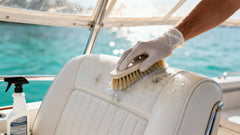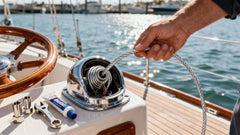How to Launch a Boat Without the Stress
Learning how to launch a boat is all about having a calm, repeatable routine that kicks off long before you ever back down the ramp. Nailing your prep in the staging area is the single most important thing you can do for a stress-free experience. This is where you turn potential ramp chaos into a smooth, efficient process.
Your Pre-Launch Prep in the Staging Area
The staging area—that designated parking lot away from the actual launch lanes—is your best friend. Seriously. Using this space correctly is the biggest courtesy you can show fellow boaters and the surest way to start your day off right. It's where you get your boat completely ready so that when it’s your turn, you’re in and out in just a few minutes.
This isn't just about ticking off a to-do list; it's about building muscle memory. Getting everything done here prevents that frantic scramble at the water's edge that causes delays, frustration, and dirty looks from other boaters. Think of it as your pre-flight check before takeoff.
Final Checks Before You Roll
First thing's first: install the drain plug. Forgetting this tiny part has ruined more boating days than any storm. It's a classic rookie mistake, so make it your number one priority.
Next, get rid of all the road gear. Remove the transom tie-down straps and the motor travel support. These are only for trailering and will literally stop your boat from floating off when you get it in the water. This is also the perfect time to load up your coolers, fishing gear, and bags.
The golden rule of the boat ramp is simple: Do all your prep work in the staging area, not in the launch lane. Your time at the ramp itself should be measured in minutes, not conversations.
To get a jump on docking, go ahead and attach your dock lines to the bow and stern cleats. While you're at it, place your fenders over the side you plan to tie up to once you launch. Lastly, tilt the engine up just enough so the lower unit will clear the pavement as you drive down to the ramp.
To help you remember every step, we’ve created the Essential Staging Area Checklist. Completing these tasks in the staging area is the key to a quick, no-fuss launch every single time.
| Task | Why It's Critical |
|---|---|
| Install Drain Plug | Prevents your boat from taking on water the second it hits the lake. |
| Remove Tie-Downs & Motor Support | Allows the boat to slide freely off the trailer once in the water. |
| Load Gear (Coolers, Bags, etc.) | Avoids a last-minute scramble and holding up the launch line. |
| Attach Dock Lines & Fenders | Makes for a quick and easy tie-up at the dock right after launching. |
| Tilt Engine Up Slightly | Protects your lower unit/propeller from scraping the ramp pavement. |
Following this routine makes launching a breeze. For a deeper dive into everything you should check, our comprehensive boat launch checklist ensures you never miss a thing. It's also smart to understand the full maintenance cycle, as knowing how to properly winterize your boat helps you know what systems need a once-over before your first launch of the season.
This systematic approach is more important than ever. The global recreational boating market is expected to swell to nearly $60.9 billion by 2033, which means more people will be sharing the ramp with you.
Confidently Backing Your Trailer Down the Ramp
For a lot of boaters, this is the moment where palms get sweaty. Let's be honest, backing a trailer is counterintuitive, but the key isn't speed or yanking the wheel—it’s all about small, deliberate corrections.
The most proven technique to make this whole process easier is to place your hand at the bottom of the steering wheel, right at the 6 o'clock position.
From here, the trailer simply moves in the same direction as your hand. Want the trailer to go left? Move your hand left. Need it to go right? Move your hand to the right. This one simple trick takes all the mental gymnastics out of reversing and gives you direct, intuitive control. Just remember to go slow and give yourself plenty of time to adjust.
Using Your Mirrors and a Spotter
Your mirrors are your best friends here. You want to focus on watching the trailer's tires in both of your side mirrors. This is the best way to see if it's staying centered on the ramp. Don't even try looking over your shoulder; your mirrors give you a much clearer picture of the trailer's angle.
A reliable spotter is also invaluable. Before you start backing up, agree on a few simple hand signals:
- Thumbs up: Keep coming back.
- Hand held up (like a stop sign): Stop immediately.
- Pointing left or right: Indicates which way the trailer needs to turn.
This infographic breaks down the essential things to check in your surroundings before you even think about putting the truck in reverse.
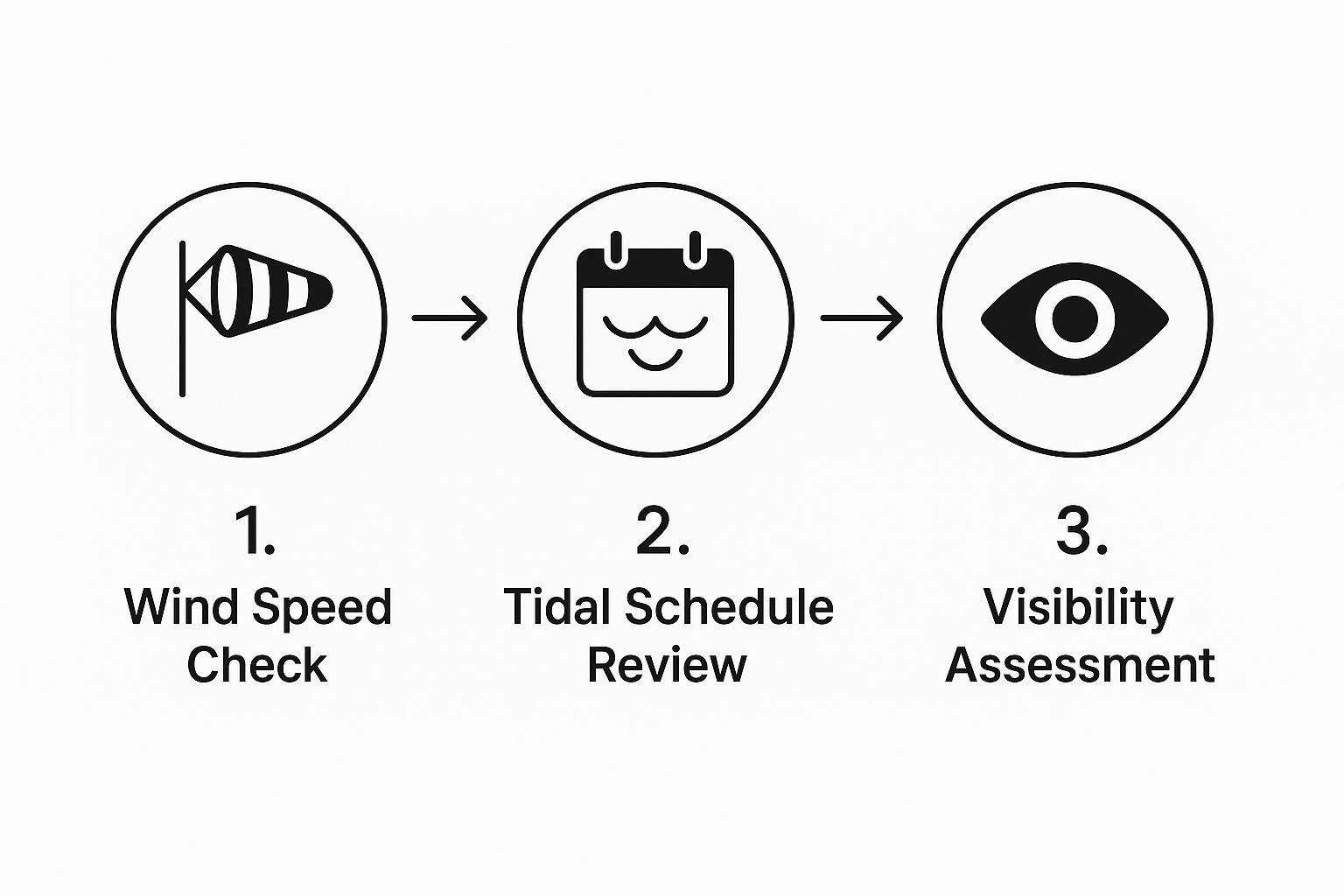
As you can see, factors like wind, tides, and visibility directly impact how difficult your launch will be, so they should absolutely guide your approach.
This careful approach is important no matter what your boat is worth. It's interesting to note that recent sales data showed a surprising trend where used boats commanded a higher average price of $211,500 compared to new boats at $174,000. You can dig deeper into these market dynamics in Boats Group's 2024 report. Whether your boat is new or used, a controlled launch protects your investment.
Pro Tip: If you get crooked, don't try to fix it by reversing more. The best move is to pull forward, straighten everything out, and start over. There’s no shame in a reset—it’s far better than risking a jackknife.
Getting the hang of the ramp goes hand-in-hand with being comfortable on the road. For more guidance, be sure to check out our article covering essential tips for towing a boat [https://betterboat.com/blogs/boating/tips-for-towing-a-boat] safely and efficiently.
Releasing Your Boat from the Trailer
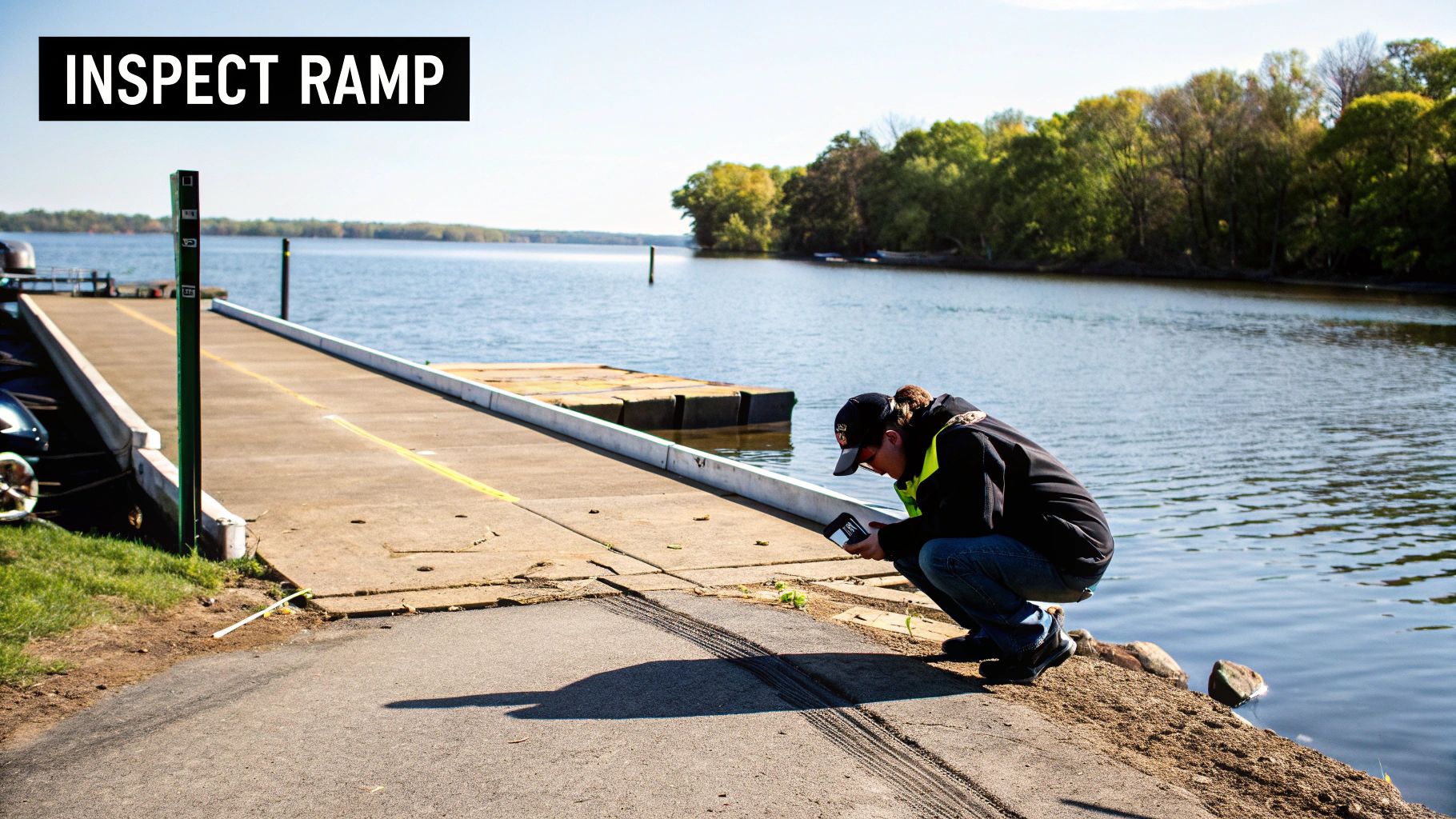
Alright, your trailer is in the water and you're moments away from the best part of the launch. The trick here is to get the boat deep enough for the stern to float on its own, but not so deep that your tow vehicle's exhaust pipe is bubbling. From my experience, a great rule of thumb is to stop backing up when the water is just licking the top of your trailer’s fenders.
This magic depth lets the water's buoyancy do most of the heavy lifting for you, setting you up for a smooth, controlled release. At this point, only two things are keeping your boat tethered to the trailer: the winch strap and the safety chain. What you do next is critical, so let’s get the order right.
Detaching in the Correct Order
First things first: unhook the winch strap from the boat's bow eye. I can't stress this enough—never, ever unhook the safety chain first. That chain is your last line of defense, the one thing preventing your boat from sliding off the trailer if the winch gives or the boat shifts unexpectedly. A ton of ramp mishaps happen simply because someone got this order backward.
With the winch strap free, you can now unhook the safety chain. Your boat should be resting gently against the trailer's bow stop, ready for its big moment.
The safety chain is your ultimate backup. It should always be the very last thing you disconnect before pushing the boat off. Reversing this step is one of the most common and dangerous mistakes made during a boat launch.
Now that everything is disconnected, a firm but gentle push on the bow is all it should take to send your boat gliding into the water. Grab those dock lines you attached earlier and guide it over to the courtesy dock. You want to keep full control so it doesn't drift off into another boater's path. The more you understand every part of your rig, including the different types of boat trailer winches available, the more confident and efficient you'll become at the ramp.
Clearing the Ramp and Securing Your Boat
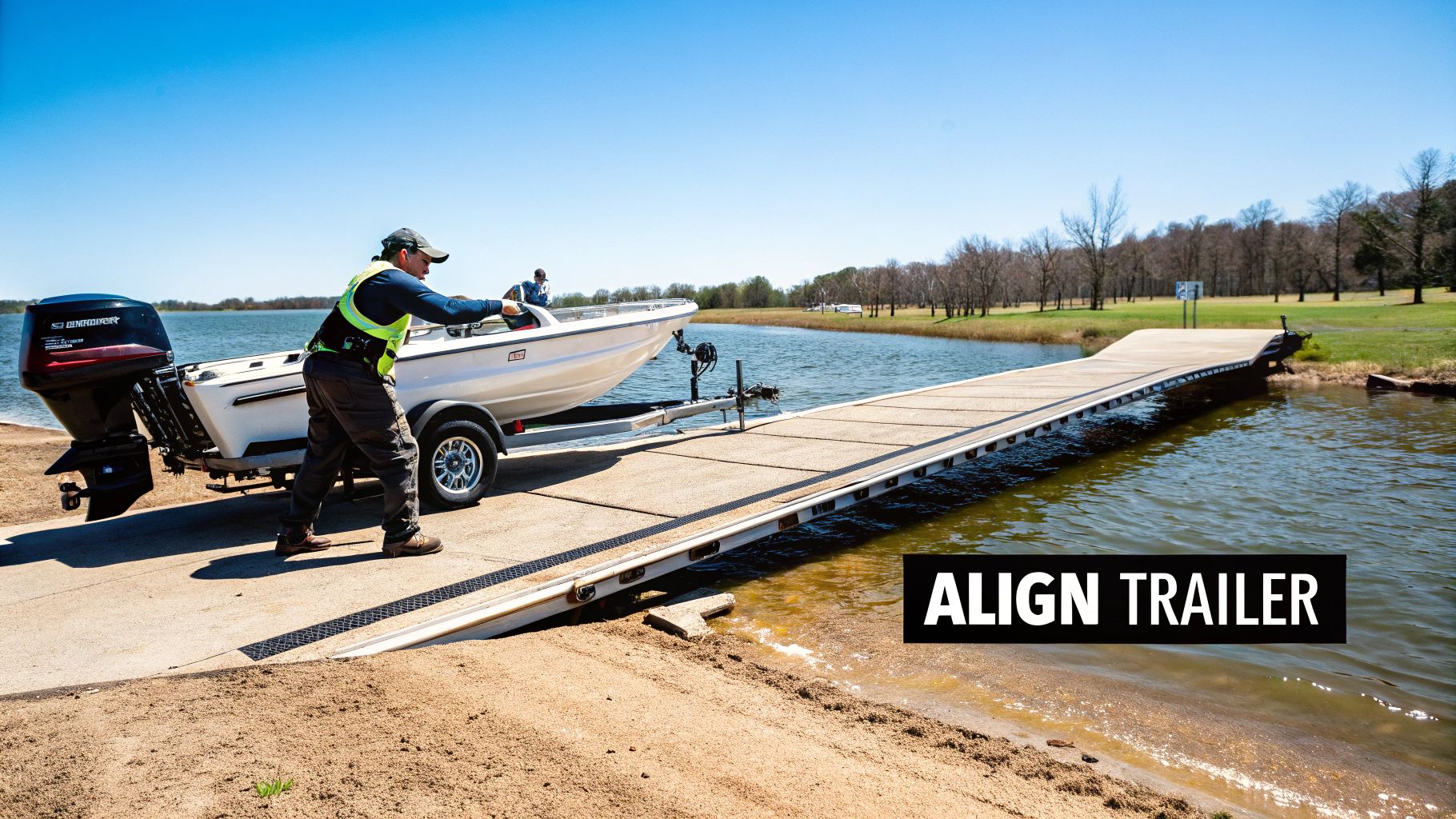 The moment your boat slides off the trailer and into the water, you're on the clock. If there’s one golden rule of ramp etiquette, it's this: get out of the way. The launch lane needs to be cleared for the next person in line, so this isn't the time to start loading coolers or grabbing your fishing gear.
The moment your boat slides off the trailer and into the water, you're on the clock. If there’s one golden rule of ramp etiquette, it's this: get out of the way. The launch lane needs to be cleared for the next person in line, so this isn't the time to start loading coolers or grabbing your fishing gear.
Your first move is to get the boat over to the courtesy dock, that temporary pier right next to the ramp. If you've got a buddy with you, they can fire up the engine and motor over slowly. Launching solo? No problem. Just use those bow and stern lines you prepped earlier to walk the boat along the dock. This gives you total control and keeps things moving—a small act that earns a lot of respect from fellow boaters.
Tying Up for a Temporary Hold
Once you're at the courtesy dock, you'll need to tie off the boat so you can go park your truck and trailer. This is just a temporary hold, so you only need it to be secure for five or ten minutes.
Grab your bow and stern lines and tie them off to two separate dock cleats. A simple, quick cleat hitch is all you need here.
- Bow Line: Secure this to a cleat that's forward of your boat's middle point.
- Stern Line: Attach this one to a cleat behind the boat's midpoint.
Don’t forget to have your fenders out before you even approach the dock. This is a rookie mistake that’s easy to avoid. Fenders prevent ugly scratches and dings on your hull, protecting your investment.
This two-line setup keeps the boat snug against the dock, preventing it from swinging into the lane or bumping other boats. It's a fundamental skill when learning how to launch a boat and builds great habits.
And those habits are more important than ever. With the U.S. boat sales market hitting an impressive $57.7 billion in 2023, there are a lot more people joining the fun on the water. You can read more in this boat marketing statistics report.
Now that your boat is safely secured, you can head off to park your vehicle with peace of mind.
Common Launching Mistakes to Avoid
We've all been there. Sitting at the ramp, watching someone else's launch turn into a slow-motion disaster. Learning how to launch a boat smoothly often means learning what not to do. Even the saltiest old-timers make mistakes, but knowing the common pitfalls can save you a ton of stress and maybe even a trip to the fiberglass repair shop.
These aren't just little "oops" moments; they can cause real damage. Let's walk through the big ones so you can avoid being "that guy" at the ramp.
The Infamous Drain Plug Fiasco
It’s the number one, hall-of-fame blunder: forgetting the drain plug. Seriously, it’s a tiny part that can cause a massive headache. Neglecting to screw it in is the fastest way to turn your pride and joy into a very temporary submarine.
Make it a non-negotiable part of your pre-launch checklist. Check it in the staging area. Then, just before you start backing down the ramp, get out and check it again. Trust me on this one.
Trailer Troubles That Keep You on Land
Another classic mistake is leaving the transom tie-down straps cinched tight. You back into the water, the boat wants to float, but it can't. It's still strapped firmly to the trailer. This puts a ridiculous amount of strain on your boat's hull, the straps, and the trailer itself. Unhook them in the prep area!
While you're at it, don't forget to unplug your trailer's electrical connector. Dunking hot trailer light bulbs into cold water is a surefire way to hear a "pop" as they burn out. This can blow fuses or fry your wiring, leading to a costly and frustrating fix. Just unplug the harness before your tires even think about getting wet.
A Scramble at the Dock
You’ve successfully floated the boat off the trailer… now what? If you didn’t get your dock lines and fenders ready beforehand, you’re in for a scramble. Picture this: your boat is drifting away while you’re rummaging through a storage locker trying to untangle a mess of ropes. It’s a stressful situation that is 100% avoidable.
- Dock Lines: Have at least your bow and stern lines already attached to the boat's cleats.
- Fenders: Go ahead and hang them on the side of the boat you plan to tie up to the dock.
A smooth launch is all about preparation, not panic. Taking a few extra minutes in the staging area to get these details sorted will save you from the most common and embarrassing blunders at the ramp.
Essential Boat Ramp Etiquette
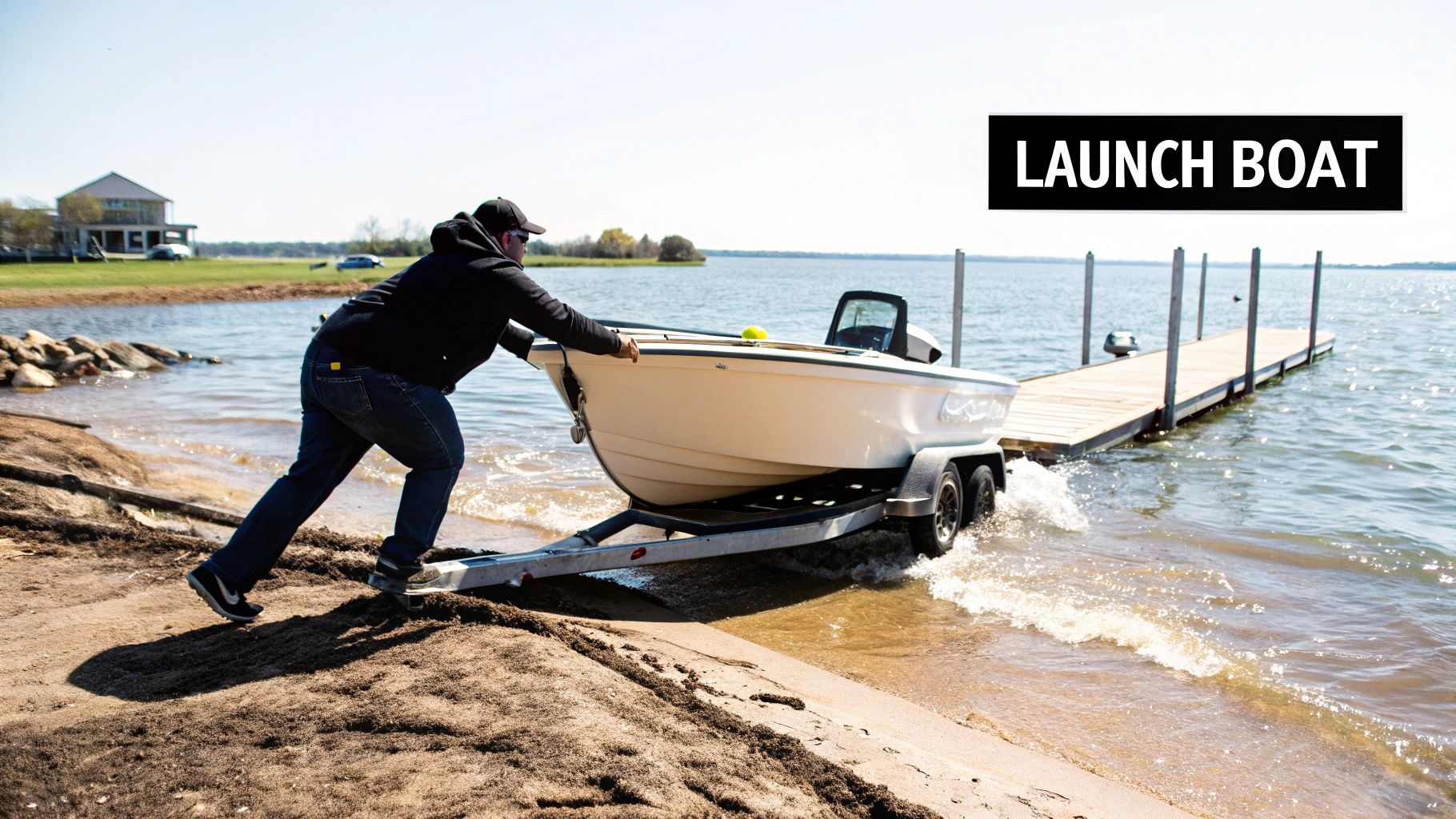 A busy boat ramp on a Saturday morning has its own rhythm. It operates on a set of unwritten rules, and mastering this etiquette is just as important as knowing how to back down your trailer. If there's one core principle to remember, it's this: efficiency is courtesy.
A busy boat ramp on a Saturday morning has its own rhythm. It operates on a set of unwritten rules, and mastering this etiquette is just as important as knowing how to back down your trailer. If there's one core principle to remember, it's this: efficiency is courtesy.
Your actual time on the launch lane should be as short as humanly possible. Think of it as the express checkout lane at the grocery store. All your gear loading, final checks, and chatting should happen in the designated staging or "make ready" area. When it’s your turn, your only job is launching your boat and getting it over to the courtesy dock.
This single act is what prevents those frustrating logjams that can ruin an otherwise perfect boating day.
Pro Tip: The biggest foul you can commit is blocking the ramp after you've launched. Once your boat is tied off at the courtesy dock, your first move should be to get your truck and trailer to a designated parking spot immediately. Don't make everyone wait while you park.
A little consideration goes a long, long way. Keep your speed down to a no-wake crawl near the ramp; you don't want to be the person rocking other boats against the docks. Launching before sunrise? Dim your headlights so you're not blinding the person backing down in front of you.
If you see someone who looks like they're struggling, offer a hand. These small gestures are what make the boating community so great.
Answering Your Top Boat Launch Questions
Even with a solid plan, things can get a little sideways at the boat ramp. You're not alone in this—every boater, from the greenest newbie to the saltiest old-timer, has been there. Let's tackle some of the most common questions head-on, so you're ready for whatever the ramp decides to throw at you.
Can You Really Launch a Boat by Yourself?
Absolutely. Learning how to handle a solo boat launch is one of the most empowering skills you can develop, and it's totally doable once you get the technique down.
The whole game is won in the prep phase. Before you even think about backing down the ramp, get a nice long bow line and coil it so it's ready to grab from the driver's seat.
Once you’ve backed in and the boat starts to float free, you can hop out, grab that line, and quickly tie it to a dock cleat. That simple move buys you all the time in the world to calmly park your truck and trailer without worrying about your boat taking a solo trip across the lake. A good set of trailer guide-ons also makes a huge difference here, especially when it's time to get the boat back on the trailer by yourself.
What’s the Trick for a Super Steep or Slippery Ramp?
Steep ramps, especially the ones with that lovely green slime, are where you slow everything way down. If your tow vehicle is a 4x4, now's the time to use it. That extra grip is your best friend.
Every move you make—steering, braking, accelerating—should be smooth and gentle. Any sudden jerks can cause you to slide.
Also, be ready for your boat to come off the trailer bunks fast. That steep angle means gravity is working against you. Have that bow line in your hand, ready to control the boat the second it pops off the trailer.
A quick but crucial safety note: Always, always make sure your vehicle's parking brake is in top-notch shape before you tackle a steep ramp. It’s the single most important piece of safety gear in this situation.
What's the Golden Rule of Ramp Etiquette?
Simple: Do your prep work in the staging area, not on the ramp. This is the one thing that keeps the line moving and everyone's blood pressure down on a busy Saturday.
By the time you pull into the launch lane, you should be 100% ready to back down, launch, and get your boat moved over to a courtesy dock. Loading up coolers, taking off the travel cover, or searching for the drain plug while blocking the ramp is the fastest way to get some dirty looks.
For all the gear that makes launching less of a headache—from top-shelf dock lines to beefy fenders—Better Boat has you covered. Swing by our site at https://www.betterboat.com and grab everything you need to make your next trip to the ramp a breeze.


